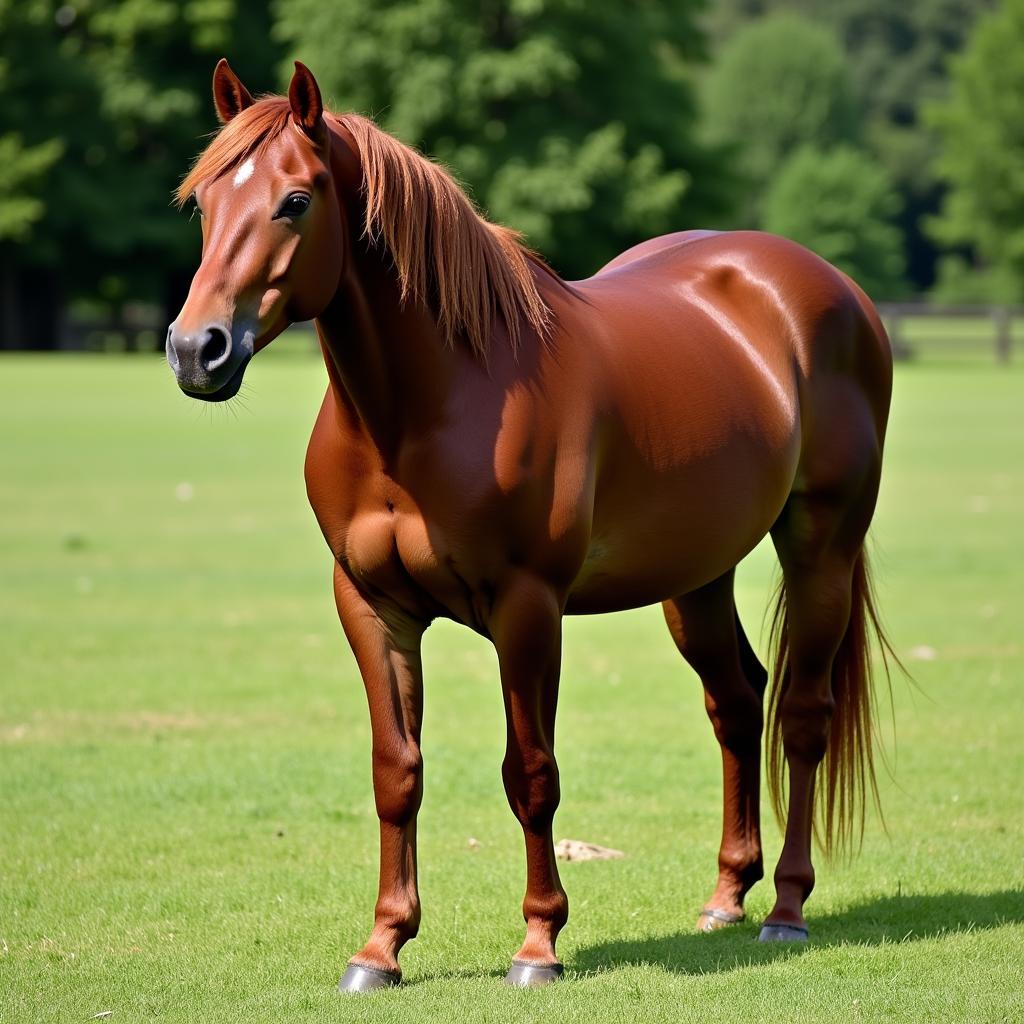The Dark Sorrel Horse, with its rich, reddish-brown coat, is a captivating sight. But what exactly defines this beautiful equine? This article delves into the genetics, characteristics, and care of the dark sorrel horse, providing a comprehensive guide for horse enthusiasts and owners alike.
Understanding the Dark Sorrel Coat
The dark sorrel horse boasts a deep, saturated shade of red, often appearing almost chocolatey in certain lights. This rich coloration is due to the extension gene (E), which allows for the production of black pigment. However, the agouti gene (A) restricts this black pigment to the points—mane, tail, and lower legs—while the body remains red. The shade of red can vary significantly, influenced by other modifying genes, creating a spectrum from a light, fiery red to a deep, almost liver chestnut hue. This variation is what distinguishes a dark sorrel from its lighter counterparts.
 Dark Sorrel Horse Standing in a Pasture
Dark Sorrel Horse Standing in a Pasture
Genetics Behind the Dark Sorrel Horse Color
The interplay of the extension (E) and agouti (A) genes is crucial in determining sorrel coat color. Horses with the genotype ee are unable to produce black pigment, resulting in base colors like chestnut or bay. For a horse to be sorrel, it must possess at least one dominant E allele. The presence of the agouti gene (A) further refines the color, restricting black pigment to the points, creating the characteristic sorrel pattern. The intensity of the red color, distinguishing a dark sorrel from a lighter one, is influenced by modifying genes that affect pigment production and distribution. These modifiers can intensify or dilute the red pigment, leading to the wide range of shades seen in sorrel horses.
 Close-Up of a Dark Sorrel Horse's Coat
Close-Up of a Dark Sorrel Horse's Coat
What Makes a Sorrel Horse “Dark”?
Several factors contribute to the darkness of a sorrel coat. Genetics play a primary role, with certain modifier genes intensifying red pigment production. Environmental factors, such as sun exposure, can also influence coat color, causing fading in lighter sorrels. Nutrition can also play a part, with a balanced diet contributing to a healthy, vibrant coat. What are some common misconceptions about dark sorrels? One common misconception is that dark sorrels are a separate breed. They are not. The sorrel coat color can occur in numerous breeds. Another misconception is that all dark sorrels have flaxen manes and tails. While this is common, the mane and tail can also be the same dark red as the body.
Caring for a Dark Sorrel Horse
Caring for a dark sorrel is similar to caring for any other horse. Providing a balanced diet, regular grooming, and appropriate shelter are essential for maintaining their health and coat condition. However, their dark coat can be more prone to sun bleaching, so providing shade during peak sun hours can help preserve the rich color.
Grooming Tips for a Dark Sorrel Coat
Regular grooming is key to maintaining a dark sorrel’s lustrous coat. Currying helps remove dirt and loose hair, while brushing distributes natural oils, promoting shine. Using a coat conditioner can enhance the color and protect it from sun damage. How often should you bathe a dark sorrel? Bathing should be done only when necessary, as excessive washing can strip the coat of its natural oils.
Identifying a Dark Sorrel
Distinguishing a dark sorrel from other shades of red can sometimes be challenging. Looking at the overall color saturation, comparing it to the mane and tail color, and observing the coat in different lighting conditions can help determine if a horse is truly a dark sorrel. Consulting with an experienced horse professional can provide additional insight.
 Dark Sorrel Horse Running in a Field
Dark Sorrel Horse Running in a Field
Dark Sorrel Horses in Equestrian Disciplines
Dark sorrel horses can be found excelling in a variety of equestrian disciplines. Their athleticism and temperament are not determined by their coat color but rather by their breed and individual training. From dressage to western riding, dark sorrels showcase their versatility and grace.
horse coat color pattern crossword clue
Conclusion
The dark sorrel horse, with its captivating coat color, is a testament to the fascinating world of equine genetics. Understanding their unique characteristics and providing appropriate care ensures these magnificent animals thrive. By appreciating the nuances of their coloration and recognizing their individual qualities, we can celebrate the beauty and versatility of the dark sorrel horse.
FAQs
- Are dark sorrels more expensive? Not necessarily. Price is determined by breed, training, and pedigree, not solely coat color.
- Do dark sorrels have specific health concerns? No, their coat color doesn’t predispose them to any specific health issues.
- Can a dark sorrel foal lighten with age? Yes, some sorrels can lighten or darken slightly as they mature.
- Are dark sorrels more prone to sunburn? Darker coats can absorb more heat, but their pigment also offers some protection.
- What other colors are similar to dark sorrel? Liver chestnut and some shades of bay can be confused with dark sorrel.
Some other questions that might be of interest: What are the different types of sorrel coat patterns? What breeds are commonly associated with the dark sorrel color? How does nutrition affect coat color in horses? For more information on other horse coat colors, consider reading our articles on horses atelier alchemical coat.
Need help? Contact us 24/7. Phone: 0772127271, Email: [email protected], Address: QGM2+WX2, Vị Trung, Vị Thuỷ, Hậu Giang, Việt Nam.